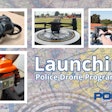The massacre of 12 students and a teacher at Columbine High School outside Denver, Colo., in April was the worst schoolyard carnage by students in this nation's history and many providing training lessons to law officers across the country for years.
"What I'll always remember is the feeling that this can't be happening," an emotional Jefferson County Sheriff's Office spokesman, Capt. Ray Fleer told POLICE a few days after the incident that captured the world's attention. The JCSO — an agency of approximately 300 sworn deputies — is handling the intense investigation of the shooting by two teens who also wounded 28 people at the school in Littleton, a town with a population of about 40,000.
The two suspects committed suicide at the scene.
Assisting in the probe have been the FBI, ATF and several police agencies.
Asked what America's police agencies could learn from the tragedy in the hopes of preventing- or al least minimizing the deaths and injuries from- these types of seemingly inevitable juvenile shooting incidents, Fleer said: "Do what you can; train and prepare as a department."
"But I think we'll all see some more lessons coming down the pike on this."
The Columbine H.S. shooting by two well-armed students from a campus group called "The Trenchcoat Mafia" was the latest in a rash of similar incidents around the country in the last 18 months. Those shootings had killed 14 people and wounded 40 others before April's massacre in Colorado.
As of POLICE's deadline, investigators were looking hard at the possibility of accomplices while trying to probe the extent to which Eric Harris, 18, and Dylan Klebold, 17, had planned their crime.
Meanwhile, a police search of Harris' home found a diary detailing a year-long plot to bomb the school, kill at least 500 classmates, murder neighbors, then hijack a jet and crash it into a major city.
Additionally, there were confirmed reports that a number of warnings about Harris had been brought to the sheriff's department's attention more than a year ago. Apparently, however, these leads had not been aggressively pursued by investigators, raising questions about how far police should go in following up tips that involve death threats and allegations of bomb making.
Media Coverage Not Accurate
Some media reports in the week following the shooting repeatedly raised issues surrounding the police response at the scene but a Jefferson County sheriff's public information officer, Deputy Wayne Halverson, told POLICE that "the media got a lot of it wrong."
"We had a deputy at the site when the incident started who was advised by a janitor that a bomb had gone off.
"That deputy immediately responded to the area, confronted one of the suspects and exchanged gunfire with him at the same time the school was calling 911.
"We had six more deputies on-scene within eight minutes," he said, adding that these officers attempted to assess the scene and maintain some kind of perimeter control while awaiting more backup units. "Some of our deputies are angry about the media coverage but more information will come out eventually about how we handled this.
"Something like this has never happened before anywhere. It's not easy or typical when you have 1,800 kids pouring out of school at you," he said. "We also know now that some students were holding doors shut out of fear, which prevented officers from getting inside the school."
As for coordination among law enforcement agencies on-site, Halverson said: "At one point we had 500-700 officers at the scene and it was a tremendous cooperative effort among local, county, state and federal law enforcement."[PAGEBREAK]
Capt. Fleer said that public concerns about police allegedly taking too long to enter the school and reach students and victims are unfounded.
"Tactical officers from several departments responded and were at the school within 30 minutes of the initial 911 call," he told POLICE, adding that the sheriff's department SWAT team was also dispatched. "That initial response involved tactical officers from our agency and the Litteton, Denver and Lakewood Police Departments.
"They formed a tactics team and a decision was made by the on-scene supervisor to make entry into the school."
Outside Views on Incident
SWAT experts POLICE spoke with commended the Jefferson County Sheriff's Office's handling of the incident.
"From what I could tell, these officers did a fantastic job under the circumstances," said Aurora (Ohio) P.D. Officer Dan Kalk, a 10-year SWAT veteran, attorney, legal advisor to Sagamore Hills (Ohio) PD and POLICE Advisory Board member, in comments typical of other SWAT and tactics professionals.
"This type of situation is just no-win for first responders," said Kalk. "They don't have a good option.
"If they go in right away, they're viewed as reckless; if they wait, then the criticism is 'they did nothing.'
"Those first officers have an obligation to establish a perimeter for safety reasons then take on any immediate threats," he added.
"Initial patrol units responding are not set up or prepared for an assault on a school. For one thing, in that kind of situation, you have no way of telling the suspects from the other students and at a school you can't know where victims and other people are located inside.
"Probably 90 percent of the departments in this country operate that way," he told POLICE.
Is There a Solution?
Can police officers, parents, teachers and others do anything in the community they serve to identify potential youth killers? Is gun control an answer?
President Clinton called upon Americans to try and stem the rising tide of teen violence while proposing, at POLICE's deadline, new gun control measures.
The crime package Clinton sent to Capitol Hill proposed several controversial restrictions on explosives and firearms, including raising the minimum age for handgun possession from 18 to 21. The White House says it would allow exemptions for police, the military and other special cases.
"We all must do more to recognize and look for the early warning signals that deeply troubled young people send," often before they explode into violence," said Clinton in published remarks shortly after the shooting.
But what of police officers and those who work with students every day?
"I think it's rare to impossible that the (gunmen) didn't have any problems before doing something like this," said Neil Sorokin, a staff psychologist who works with violent adolescents at the Colorado Mental Health Institute at Fort Logan.
"It almost never happens that someone would kill people without having had significant problems. And it's also true that access to guns is the biggest predictor for people committing homicides. If kids don't have funs, these kinds of situations don't escalate as fast. Knives and fists can't hurt or kill as many people as easily as guns can."
Rob Clyman, director of the Kempe National Center for Prevention and Treatment of Child Abuse at Children's Hospital, said "a fairly large percentage of adolescents who are committing violent acts have had trouble since they were very young- like 5 or 7 years old." Although, "when you're dealing with a terribly unusual type of event (Like the Columbine High schooting0, it's hard to talk about what would lead kids to do something this aberrant," Clyman said.
Dennis Hall is the executive editor of POLICE and a former police officer for several California jurisdictions. He editorialized on the issue of youth violence last July following an incident in Oregon in which a 15-year old boy opened fire on classmates killing four and wounding 22. Some information for this report provided by The Denver Post.












